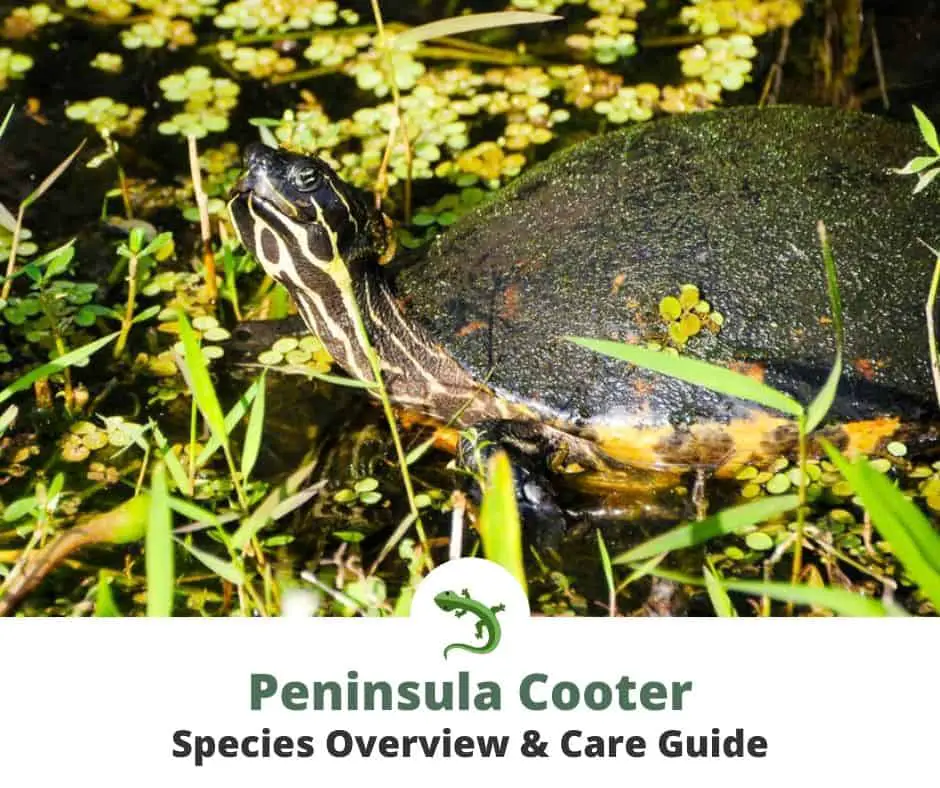The Peninsula Cooter species of turtles have dark shells with vivid patterns and are closely related to River Cooters. These turtles grow quite large and can live up to 30 years!
In this guide, you’ll learn:
- What makes a Peninsula Cooter unique?
- How do you properly take care of a Peninsula Cooter?

Species Overview
Appearance & Size
The Peninsula Cooter is a medium-sized aquatic turtle native to the southeastern United States. It has a dark green or black carapace (shell) with yellow markings and a bright yellow plastron (bottom shell). Its head, neck, and legs are also brightly colored in shades of yellow, orange, red, and black. The average size of an adult Peninsula Cooter ranges from 9-15 inches long.
They have short necks compared to other aquatic turtles, so they tend not to get too large even when kept in larger tanks or ponds where food sources are plentiful for them to feed upon throughout their life span as adults.
Lifespan
Peninsula cooters can live up to 40 years in captivity if provided with proper care. Wild populations typically only live between 10-20 years due to environmental conditions like predators and disease. Therefore, to help your pet cooter reach its entire potential lifespan, it must receive adequate nutrition and captive living requirements.
Pro-Tip ⚡
Captive turtles should receive 10-gallons of tank space per inch of shell length. For example, a cooter that is 10 inches long should be housed in a 100-gallon tank.
Behavior, Temperament & Handling
Cooters are much shyer when compared to Red-eared sliders and painted turtles.
The Peninsula Cooter is an active species that loves to explore its environment. It is most active during the day and often basks in the sunlight for warmth and energy. In captivity, it may become accustomed to being handled if done correctly but usually prefers exploring over being held for long periods of time. Cooters have strong territorial instincts, which means they may become aggressive toward other reptiles if kept together in the same enclosure.
Reptiles like the Peninsula Cooter should always be handled with care. It is important to use two hands when handling a reptile and to support its body from underneath.
For example, when picking up a Peninsula Cooter, it is best to do so slowly and gently by placing one hand on either side of its shell near the back legs. Never pick up a reptile by its tail or head as this can cause injury.
Pro-tip ⚡
Peninsula Cooters do not like to be handled, so they will often bite out of self-defense. Captive cooters are not as aggressive as wild ones.
How To Care For Peninsula Cooters
Housing The Peninsula Cooter
There are several important factors to consider when it comes to tank requirements for a Peninsula Cooter.
Size Requirements: The size of the tank is an essential factor when housing a Peninsula Cooter. Generally speaking, you should provide at least 10 gallons of space per turtle, but larger tanks are preferable. This will give your pet plenty of room to move around and explore its environment without feeling cramped or overcrowded.
Temperature and Lighting Requirements: Temperature and lighting requirements are essential for keeping your Peninsula Cooter healthy and happy. They require temperatures between 75-85 degrees Fahrenheit during the day with access to UVB light from either natural sunlight or artificial bulbs explicitly designed for reptiles. Additionally, they need cooler temperatures (65-75 degrees Fahrenheit) to properly digest their food and rest comfortably throughout the night.
Humidity: It is important to monitor humidity levels closely; too much moisture can cause respiratory infections, while not enough can lead to dehydration in turtles. A good rule of thumb is 70-80% relative humidity during the day and 60-70% at night. If necessary, use a hygrometer to measure these levels accurately over time so adjustments can be made. Maintaining the correct tank requirements is essential for providing a healthy and comfortable habitat for your Peninsula cooter.
Pro-tip ⚡
Stock tanks or liner ponds are great enclosures for Peninsula Cooters. Typical glass aquariums are not usually large enough to house these species, since they can grow very large.
📚 Read More >> Best Turtle Tank Heaters
Diet Requirements
Peninsula Cooters eat mainly plant material and are herbivores. Various vegetables, fruits, and commercial reptile foods like pellets or freeze-dried insects are perfectly fine.
Vegetables such as collard greens, kale, squash, carrots, and sweet potatoes are all excellent options for providing essential vitamins and minerals to your pet.
Fruits like apples, pears, and berries can also be given occasionally as treats. It’s essential to make sure that any produce you give is pesticide free before offering it to your reptile companion.
Pro-Tip ⚡
Feed every day or every other day for hatchlings and up to 3 times per week for adults. Hatchlings require more protein in their data until they become adults.
Maintaining Good Water Quality
High water quality is necessary for keeping a healthy cooter. Use a strong filter rated for 2-3 times the aquarium size to reduce water changes.
📚 Read More >> How To Fix Cloudy Turtle Tank
Tips For Handling Peninsula Cooters
In captivity, it may become accustomed to being handled if done correctly but usually prefers exploring over being held for long periods of time. Cooters have strong territorial instincts, which means they may become aggressive toward other reptiles if kept together in the same enclosure. Proper handling and understanding of typical behaviors are essential for providing the best care for your Peninsula cooter.
Important
Frequent handling can cause stress, so don’t make it a habit. Cooters will bite so keep your hands away from their mouth while handling.



